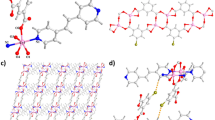Abstract
In the present study, a new fluorescent Tb(III)-based coordination polymer (CP) with the chemical formula of [Tb(TCPB)(DMF)3]n (1) has been presented via using a mixed-donor ligand 1,3,5-tris(1-(2-carboxyphenyl)-1H-pyrazol-3-yl)benzene (H3TCPB) under the solvothermal reaction conditions. CP 1 becomes the predominated selection for luminescence probing experiments because of the highly developed stability in watery reagent and Lewis basic centers. Furthermore, the prevention ability of the synthetic compound against bacterial infection induced by Staphylococcus aureus during hemodialysis with renal failure was evaluated. With the help of molecular docking simulation, it can be seen from the molecular level that both carboxyl and pyrazole groups on the Tb complex are responsible for the binding interactions and therefore they are the origin of biological activities.







Similar content being viewed by others
Data Availability
The data used to support the findings of this study are included within the article.
References
V. Jankowski, T. Günthner, S. Herget-Rosenthal, W. Zidek, J. Jankowski, Dinucleoside polyphosphates and uremia. Semin. Dial. 22, 396–399 (2009)
P.E. Teschan, On the pathogenesis of uremia. Am. J. Med. 48, 671–677 (1970)
H. Mischak, Z.A. Massy, J. Jankowski, Proteomics in uremia and renal disease. Semin. Dial. 22, 409–416 (2009)
J.N. Hao, B. Yan, A dual-emitting 4d–4f nanocrystalline metal–organic framework as a self-calibrating luminescent sensor for indoor formaldehyde pollution. Nanoscale 8, 12047–12053 (2016)
S. Tang, M. Zhao, D. Yuan, X. Li, Z. Wang, X. Zhang, T. Jiao, J. Ke, Fe3O4 nanoparticles three- dimensional electro-peroxydisulfate for improving tetracycline degradation. Chemosphere 268, (2021)
X.Y. Shangguan, B.L. Fang, C.X. Xu, Y. Tan, Y.G. Chen, Z.J. Xia, W. Chen, Fabrication of direct Z-scheme FeIn2S4/Bi2WO6 hierarchical heterostructures with enhanced photocatalytic activity for tetracycline hydrochloride photodegradation. Ceram. Int. 47, 6318–6328 (2021)
X. Feng, R.F. Li, L.Y. Wang, S.W. Ng, G.Z. Qin, L.F. Ma, A series of homonuclear lanthanide coordination polymers based on a fluorescent conjugated ligand: syntheses, luminescence and sensor. CrystEngComm 17, 7878–7887 (2015)
X. Feng, Y.Q. Feng, L. Liu, L.Y. Wang, H.L. Song, S.W. Ng, A series of Zn-4f heterometallic coordination polymers and a zinc complex containing a flexible mixed donor dicarboxylate ligand. Dalton Trans. 42, 7741–7754 (2013)
J.X. Li, Z.X. Du, A binuclear Cadmium(II) cluster based on π···π stacking and halogen···halogen interactions: synthesis, crystal analysis and fluorescent properties. J. Clust. Sci. 31, 507–511 (2020)
J.X. Li, Z.X. Du, L.L. Zhang, D.L. Liu, Q.Y. Pan, Doubly mononuclear cocrystal and oxalato-bridged binuclear copper compounds containing flexible 2-((3,5,6-trichloropyridin-2-yl)oxy) acetate tectons: synthesis, crystal analysis and magnetic properties. Inorg. Chim. Acta 512, (2020)
H. Chen, L. Fan, X. Zhang, Highly robust 3 s − 3d {CaZn} − organic framework for excellent catalytic performance on chemical fixation of CO2 and Knoevenagel condensation reaction. ACS Appl. Mater. Interfaces. 12, 54884–54892 (2020)
J.M. Seco, I. Oyarzabal, S. Pérez-Yáñez, J. Cepeda, A. Rodríguez-Diéguez, Designing multifunctional 5-cyanoisophthalate-based coordination polymers as single-molecule magnets, adsorbents, and luminescent materials. Inorg. Chem. 55, 11230–11248 (2016)
N. Chen, M.X. Li, P. Yang, X. He, M. Shao, S.R. Zhu, Chiral coordination polymers with SHG-active and luminescence: an unusual homochiral 3D MOF constructed from achiral components. Cryst. Growth Des. 13, 2650–2660 (2013)
H. Chen, L. Fan, X. Zhang, L. Ma, Nanocage-based InIII{TbIII}2-organic framework featuring lotus-shaped channels for highly efficient CO2 fixation and I2 capture. ACS Appl. Mater. Interfaces. 12, 27803–27811 (2020)
J.J. Liu, S.B. Xia, Y.L. Duan, T. Liu, F.X. Cheng, C.K. Sun, Anion-controlled architecture and photochromism of naphthalene diimide-based coordination polymers. Polymers 10, 165 (2018)
Y. Hu, M. Ding, X.Q. Liu, L.B. Sun, H.L. Jiang, Rational synthesis of an exceptionally stable Zn(ii) metal–organic framework for the highly selective and sensitive detection of picric acid. Chem. Commun. 52, 5734–5737 (2016)
J. Tian, Q. Liu, J. Shi, J. Hu, A.M. Asiri, X. Sun, Y. He, Rapid, sensitive, and selective fluorescent DNA detection using iron-based metal-organic framework nanorods: synergies of the metal center and organic linker. Biosens. Bioelectron. 71, 1–6 (2015)
W. Wang, Y.X. Wang, H.B. Yang, Supramolecular transformations within discrete coordination-driven supramolecular architectures. Chem. Soc. Rev. 45, 2656–2693 (2016)
L.N. Zheng, F.H. Wei, H.M. Hu, C. Bai, X.L. Yang, X. Wang, G. Xue, Lanthanide coordination polymers constructed from the asymmetrical N-heterocyclic rigid carboxylate: synthesis, crystal structures, luminescence properties and magnetic properties. Polyhedron 161, 47–55 (2019)
X. Liang, Y. Jia, Z. Zhan, M. Hu, A highly selective multifunctional Zn-coordination polymer sensor for detection of Cr(III), Cr(VI) ion, and TNP molecule. Appl. Organomet. Chem. 33, 15399–15402 (2019)
M.M. Fitzgerald, R.A. Musah, D.E. McRee, D.B. Goodin, Variation in strength of an unconventional C-H to O hydrogen bond in an engineered protein cavity. J. Am. Chem. Soc. 119, 626–631 (1997)
Author information
Authors and Affiliations
Corresponding author
Ethics declarations
Conflicts of interest
The author(s) declare(s) that there is no conflict of interest regarding the publication of this paper.
Additional information
Publisher's Note
Springer Nature remains neutral with regard to jurisdictional claims in published maps and institutional affiliations.
Rights and permissions
About this article
Cite this article
Liu, J., Cheng, Y. & Li, D. A New Tb(III) MOF for Selective Detection of Cu2+ Ion and Prevention Ability Against Staphylococcus aureus Biofilm Formation on Patients with Renal Failure. J Inorg Organomet Polym 31, 3525–3533 (2021). https://doi.org/10.1007/s10904-021-01982-7
Received:
Accepted:
Published:
Issue Date:
DOI: https://doi.org/10.1007/s10904-021-01982-7




